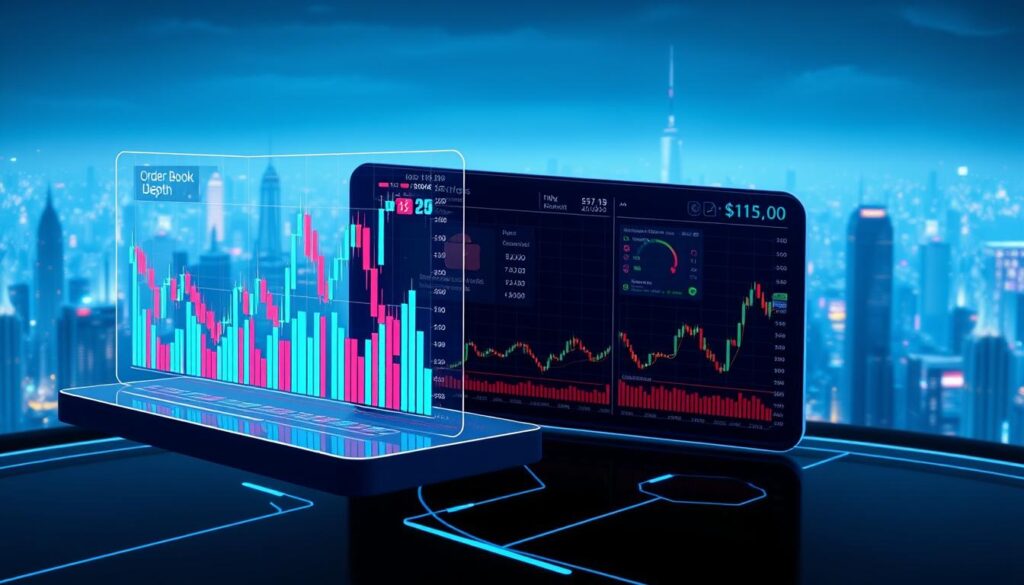Now Reading: Insights into Crypto Market Maker Activity Analysis and Order Book Depth Interpretation
- 01
Insights into Crypto Market Maker Activity Analysis and Order Book Depth Interpretation
Insights into Crypto Market Maker Activity Analysis and Order Book Depth Interpretation

Digital asset exchanges rely on specialized participants to keep trades flowing smoothly. These entities place constant buy and sell orders, creating reliable entry and exit points for traders. Their efforts prevent drastic price swings and ensure assets can be traded even during volatile periods.
When these liquidity providers operate effectively, they bridge the gap between buyers and sellers. This reduces the risk of sudden price gaps forming during rapid market shifts. Traders benefit from tighter bid-ask spreads, making transactions more cost-effective across various price levels.
The visibility of pending trades at different price points offers critical insights. By studying these layered orders, investors gauge potential support/resistance zones and detect emerging trends. This data helps professionals assess market sentiment and adjust strategies accordingly.
Key Takeaways
- Liquidity providers maintain consistent trading opportunities across digital asset platforms
- Effective order placement strategies minimize price fluctuations during volatile periods
- Real-time trade queue analysis reveals hidden supply and demand patterns
- Bid-ask spread tightness directly impacts transaction costs for all participants
- Professional traders use layered order data to predict short-term price movements
Understanding Market Making: The Backbone of Crypto Liquidity
Financial markets thrive when participants can quickly execute trades at predictable prices. Specialized entities called market makers fulfill this need by constantly quoting buy and sell prices. Their presence transforms fragmented trading environments into smooth ecosystems.
What Is Market Making?
This practice involves placing simultaneous buy and sell orders for assets. Providers profit from the bid-ask spread – the gap between purchase and sale prices. Advanced algorithms adjust these quotes millisecond-by-millisecond to balance risk and reward.
Three primary revenue streams drive this activity:
- Capturing differences between buying and selling prices
- Earning rebates from platforms based on trade volume
- Exploiting temporary price mismatches across exchanges
Sustaining Trading Efficiency
Effective liquidity providers act as shock absorbers during volatility spikes. They prevent wild price swings by keeping orders active during selloffs or buying frenzies. This stability benefits all participants through:
- Tighter bid-ask spreads
- Reduced transaction costs
- Consistent order execution speeds
Modern platforms present unique challenges like non-stop trading hours and decentralized architectures. Providers adapt by using AI-driven tools that monitor multiple exchanges simultaneously. These systems respond faster than human traders ever could.
Fundamentals of Order Book Depth and Its Importance
Trading platforms display real-time layers of demand and supply through their order systems. These dynamic lists show what traders want to buy or sell at specific values. The thickness of these layers determines how easily large transactions occur without disrupting asset valuations.

Decoding Buy and Sell Orders
Every trading pair features two distinct queues. The green zone represents pending purchase requests below current value. Red zones show sell proposals above prevailing rates. Thick clusters at certain levels often act as barriers against sudden shifts.
Three elements define these queues:
- Quantity available at each price tier
- Total volume across all active proposals
- Speed at which new orders replace filled ones
Interpreting Liquidity through Depth Charts
Visual tools map accumulated orders across value points. Steep slopes indicate strong resistance, while flat areas suggest vulnerability to price moves. Traders watch for asymmetries where buy walls dwarf sell pressure, or vice versa.
A deep order book typically signals stable conditions. It allows substantial trades with minimal slippage. For practical insights, review this order book depth analysis showing real-world patterns.
Sharp traders monitor how these charts evolve during news events. Rapid thinning often precedes volatility, while gradual thickening indicates consolidation. This data helps anticipate short-term movements before they appear on price graphs.
Crypto market maker activity analysis and order book depth interpretation
Large transactions reveal hidden stories about digital asset behavior. When buyers or sellers execute substantial trades, the ripple effects expose critical liquidity conditions. Depth charts and volume metrics become compasses for navigating these waters.

Analyzing Trading Volume and Price Impact
Thick order books absorb big transactions like sponges. A $1 million trade might only shift values by 0.08% in liquid markets. Thin queues amplify impacts – the same trade could push prices 1.2% in volatile conditions.
Three signals help spot liquidity changes:
- Spikes in 24-hour transaction counts
- Shrinking gaps between bid/ask tiers
- Rapid order replenishment after large fills
Professionals track execution quality using slippage benchmarks. Platforms with under 0.10% average slippage typically show strong institutional participation. Values above 0.30% often indicate retail-dominated environments where sudden moves occur.
Data patterns reveal hidden strategies. Consistent midday volume surges might suggest algorithmic programs. Unusually balanced buy/sell ratios could point to wash trading. Savvy traders cross-reference these clues with real-time depth charts to confirm trends.
Getting Started with Crypto Trading Fundamentals
New entrants must master essential concepts to avoid common pitfalls. Blockchain platforms operate differently than traditional markets, requiring familiarity with unique tools and terms. This knowledge helps identify profitable opportunities while managing volatility.

Key Terms and Beginner Concepts
The bid-ask spread reflects immediate transaction costs. Narrow gaps signal liquid assets, while wide spreads suggest scarce buyers or sellers. Always compare this metric across exchanges before trading.
Two primary order types shape transactions:
| Order Type | Execution | Price Control |
|---|---|---|
| Market Orders | Instant fill | No guarantee |
| Limit Orders | Conditional | Full control |
Slippage occurs when actual execution prices differ from expectations. This risk grows during fast-moving markets. Centralized platforms often handle large volumes better than decentralized alternatives, affecting trade outcomes.
Three critical risks demand attention:
- Price swings exceeding 10% within hours
- Platform reliability during peak activity
- Counterparty defaults in peer-to-peer deals
Beginners should practice with small amounts using limit orders. Track how spreads and liquidity change across daytime hours. This builds intuition for spotting favorable entry points.
Market Makers and Liquidity: Fueling Token Success
Successful token ecosystems depend on continuous buying and selling pressure to thrive. Specialized participants bridge gaps between traders, creating an environment where assets can flow freely. This foundation determines whether projects gain traction or fade into obscurity.
Enhancing Price Stability and Reducing Slippage
Market makers act as stabilizers in volatile environments. By constantly quoting both buy and sell prices, they compress bid-ask spreads. Tight spreads mean traders pay less to enter or exit positions.
Consider these comparisons for tokens with active liquidity support versus those without:
| Feature | With Market Makers | Without Market Makers |
|---|---|---|
| Average Spread | 0.15% | 1.8% |
| Price Swing (24h) | ±3% | ±12% |
| Large Trade Impact | 0.5% Slippage | 4.2% Slippage |
Institutional players avoid tokens lacking order book depth. Thin liquidity makes executing large positions risky. Projects with professional market making see 3x more daily volume on average.
This creates a cycle: better liquidity attracts more traders. Increased trading activity then draws listings on top exchanges. Case studies show tokens with dedicated support maintain valuations 40% higher during downturns.
Risk Management Strategies in Crypto Market Making
Volatile digital asset environments demand robust protection frameworks for liquidity providers. Specialized entities employ layered approaches to balance profitability with exposure. These methods ensure continuous operations despite sudden price swings.

Inventory control forms the first defense line. Providers diversify holdings across multiple assets to avoid overexposure. This approach spreads risk while capturing opportunities in different trading pairs.
Advanced hedging techniques neutralize directional risks. Common methods include:
| Strategy | Purpose | Example |
|---|---|---|
| Futures Contracts | Lock prices | BTC quarterly futures |
| Options | Limit downside | ETH put options |
| Cross-Exchange Arbitrage | Exploit price gaps | Simultaneous trades on 3 platforms |
Position sizing adapts to market conditions. Algorithms adjust trade volumes based on real-time volatility readings. This prevents oversized exposures during turbulence.
Automated safeguards protect against extreme events. Systems trigger:
- Immediate order cancellations
- Spread widening during news spikes
- Forced position reductions
Operational risks require constant monitoring. Providers vet exchange reliability and maintain backup API connections. Regulatory compliance checks prevent legal bottlenecks across regions.
How Order Book Depth Influences Trading Decisions
Traders often look beyond price charts to make informed decisions. Real-time order queues reveal hidden supply and demand patterns that shape asset valuations. These layered queues act as a roadmap, showing where buyers and sellers might clash.
Spotting Support and Resistance Levels
Clusters of pending orders create invisible barriers. A thick stack of buy requests at $49,500 for Bitcoin often halts downward moves. Conversely, dense sell orders at $51,200 could cap upward momentum.
Three signals help identify genuine barriers:
- Volume concentration: 70%+ of orders within 1% price range
- Order replenishment: Quickly refilled queues after large trades
- Time persistence: Walls remaining intact through multiple price tests
Sophisticated participants sometimes create fake walls to manipulate expectations. Genuine support zones typically show gradual order accumulation, while deceptive ones vanish when prices approach. Iceberg orders – large hidden positions – leave subtle clues through unusually slow queue depletion.
Short-term traders focus on immediate order flow changes near current prices. Long-term analysts track broader accumulation patterns across weeks. Combining both approaches helps distinguish temporary fluctuations from structural shifts.
Integrating this data with chart patterns increases accuracy. A head-and-shoulders formation becomes more credible when coinciding with thinning sell-side depth. This dual confirmation helps traders avoid false breakouts.
Integrating Data and Analytics into Crypto Trading
Modern trading strategies thrive on instant information flow and precise decision-making. Professionals combine multiple data streams to spot patterns invisible to casual observers. This approach transforms raw numbers into actionable intelligence.
Leveraging Real-Time Market Data
Platforms like CoinMarketCap provide millisecond updates on asset valuations and liquidity metrics. These feeds help traders identify sudden shifts in buy/sell pressure. Real-time tracking becomes crucial when executing time-sensitive positions.
Heatmaps visually highlight concentration areas in order queues. Color gradients show where large clusters of bids or asks gather. This helps anticipate potential price barriers before they appear on charts.
Utilizing Tools for Enhanced Insights
Advanced dashboards aggregate exchange data across platforms. Custom alerts notify users when specific liquidity thresholds get crossed. Predictive models analyze historical patterns to forecast short-term movements.
Many systems now integrate machine learning to refine strategy performance. These tools adapt to changing conditions, improving accuracy with each trade. Successful traders balance automated signals with human judgment for optimal results.
Combining these methods creates a competitive edge in fast-paced environments. Those who master data-driven approaches often achieve better consistency across market cycles.















